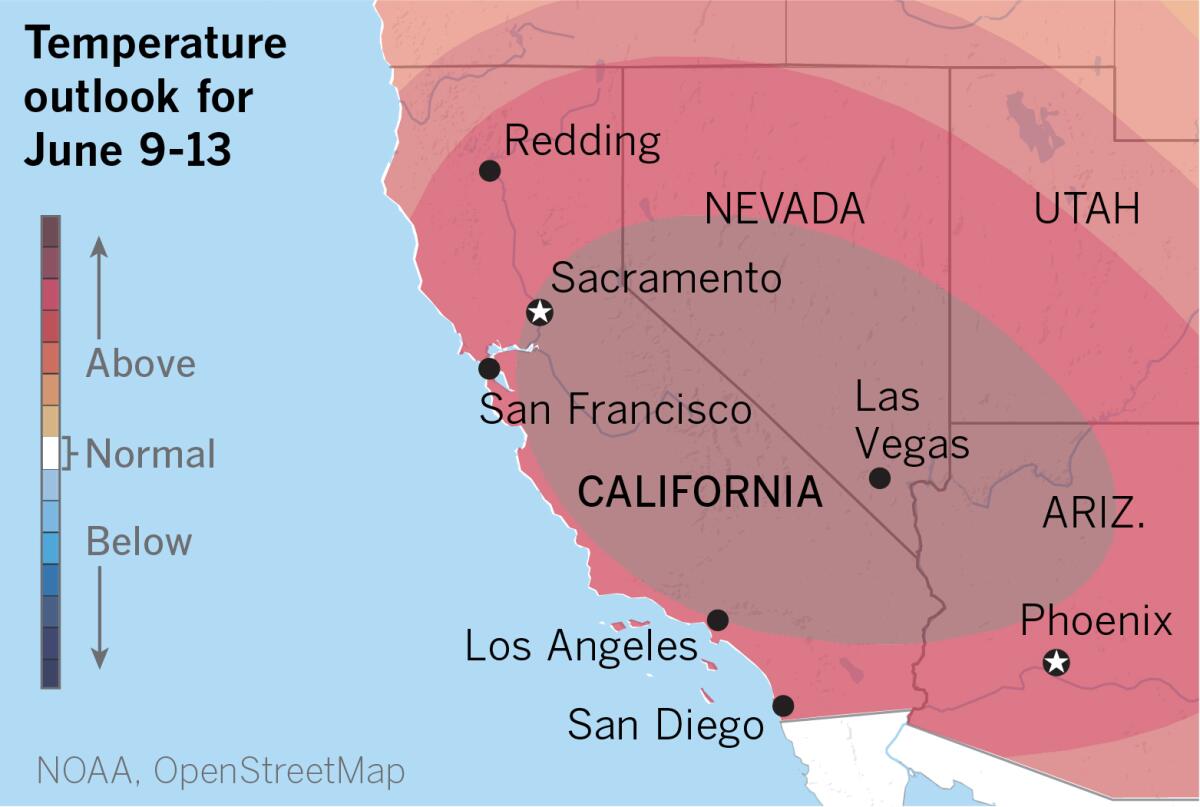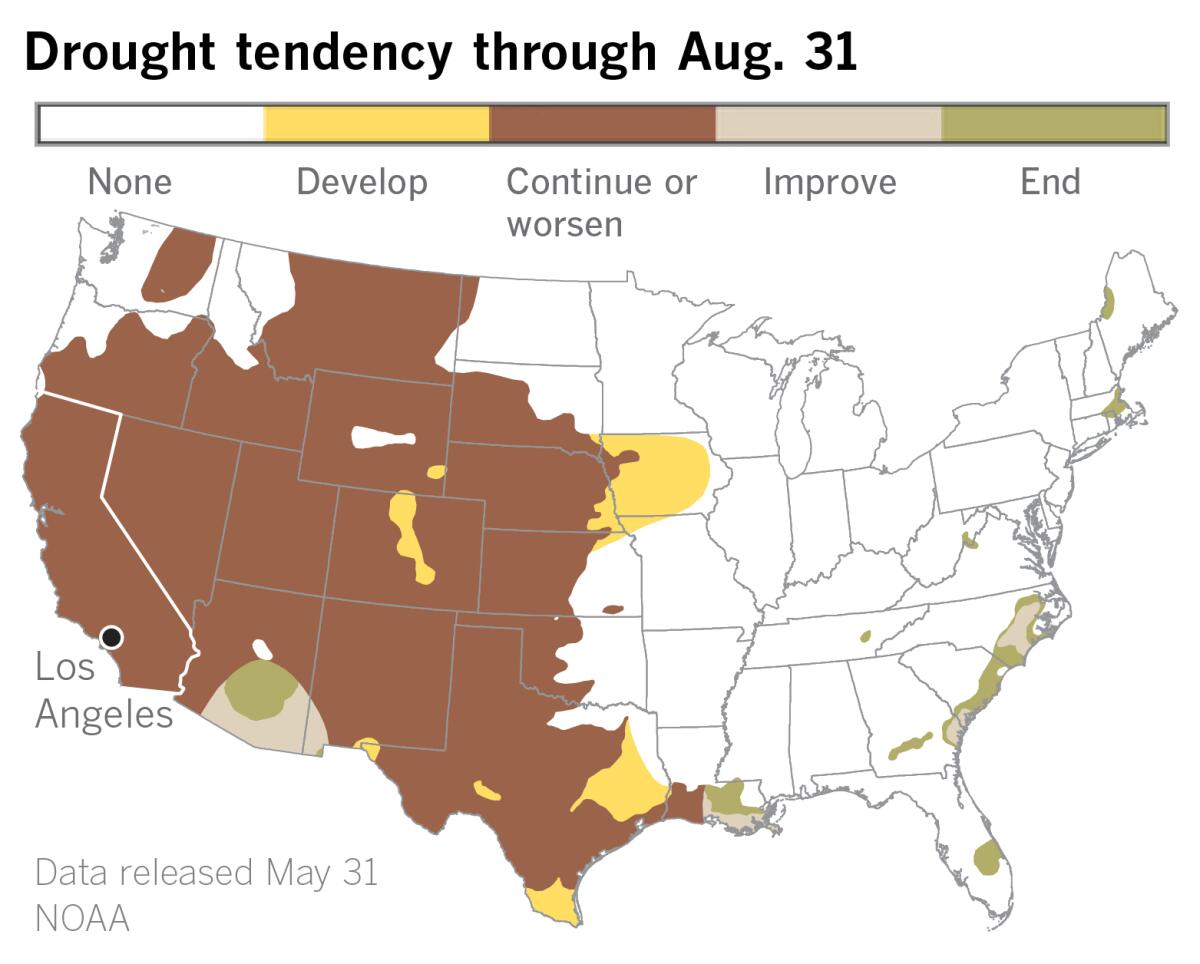After a cool, cloudy weekend, a statewide heat wave is on tap for California next week

- Share via
After a cool and cloudy weekend, Southern California can expect to see the heat return next week, particularly in inland, valley and desert areas, forecasters say.
The heat wave will likely be the hottest of the season, with some areas seeing temperatures spike by 20 degrees or more, said Eric Boldt, a meteorologist with the National Weather Service in Oxnard. Some inland areas could could see triple digit temperatures as early as midweek.
Coastal regions and most of the Los Angeles metro area “will not be that hot — closer to 10 degrees above normal,” he said. For example, while the temperature in downtown L.A. is normally about 75 degrees this time of year, temperatures are expected to be closer to 85 by late next week.
For the weekend, cooling onshore winds will create a coastal eddy, spinning low clouds and fog inland during nights and mornings in a typical seasonal pattern, with temperatures ranging from the high 60s to mid-70s along the coast. Early June is the most gloomy time of year in Southern California, but that is expected to change dramatically in the next few days.
The six-to-10 day forecast from the National Oceanic and Atmospheric Administration shows above-normal temperatures across the West. Most of Southern California is expected to see above-normal temperatures during this period.
High pressure in the eastern Pacific — where it has been unusually strong and persistent over the past two years — is expected to move over California later next week, then into the Southwest and progressively eastward, said Alex Tardy, a meteorologist with the weather service in San Diego.
The high-pressure ridge is expected to increase as it moves through interior Northern California and into the Intermountain West, forecasters say, with high temperatures climbing from 10 degrees above normal Tuesday to 20 degrees above normal by the end of the week. The Central Valley can expect triple-digit heat Thursday and Friday.
But before the heat starts, Northern California is looking at chances for widespread rain this weekend, especially Saturday night and Sunday, the weather service said.
“Pretty rare to see some potential for meaningful June rainfall in parts of NorCal immediately before what could be a prolonged and potentially record-breaking heatwave just a few days later,” tweeted UCLA climate scientist Daniel Swain.

Any rain is welcome, but it would take a lot more than a few passing showers to dent California’s ongoing drought. The most recent U.S. Drought Monitor data, released Thursday, shows close to 12% of the state categorized as being in exceptional drought.
Most of the area in this worst category is in a makau — a hook-shaped portion of land — covering the southern Sierra Nevada and wrapping around the south end of the San Joaquin Valley. Another narrow sliver is in extreme eastern San Bernardino County, on the Nevada border.
Almost half of California — 48% — is in extreme drought, the second-worst category. Another 38% is in severe drought, and 2.3% is in moderate drought, mostly in the western half of San Diego County. The remaining 0.14% of the state is considered abnormally dry.

Except for parts of the Pacific Northwest, the entire continental U.S. west of the 100th meridian, as well as more than half of Texas and parts of the central and southern Plains, are in areas where drought is forecast to develop, continue or worsen through the end of August. Southern Arizona and southwestern New Mexico are expected to improve because an enhanced monsoon is predicted for this summer.
Strong high pressure, like what is expected to grip the region next week, squeezes out the marine layer, the protective heat shield that usually protects coastal California from the brunt of the sun’s power when it is highest in the sky (the summer solstice is June 21). Without this sunscreen of stratus clouds, temperatures are likely to increase along with the evaporative demand — or atmosphere’s thirst — that sucks moisture out of soils and vegetation and elevates fire danger.
There is one element of uncertainty about how much high pressure will press down on the atmosphere, warming the air late next week in Southern California, according to Miguel Miller, another meteorologist with the weather service in San Diego.
Underneath the ridge of high pressure spreading into the West Coast from the eastern Pacific, models show an inverted trough of weak low pressure approaching off the coast of Baja. The rising air from this low pressure system could weaken the dominant high pressure enough to maintain a little more robust marine layer west of the mountains.
More to Read
Sign up for Essential California
The most important California stories and recommendations in your inbox every morning.
You may occasionally receive promotional content from the Los Angeles Times.














